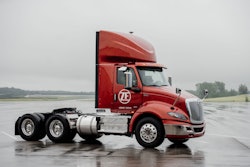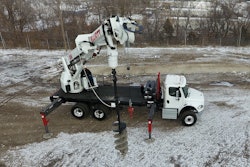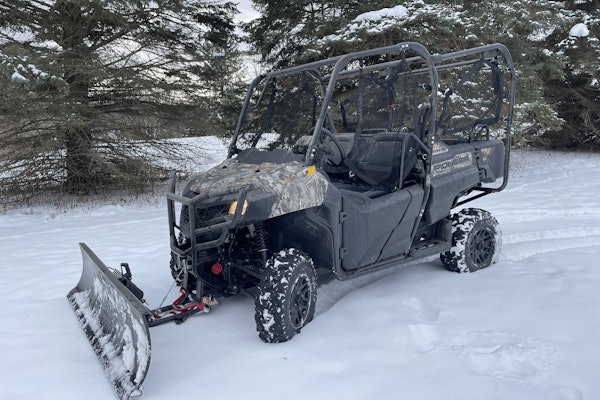Milwaukee Tools has been on a tear lately, introducing multiple lines of tools and accessories aimed at specific trades. The relevant news for Equipment World readers is that they’ve created a tool category called “Transportation Maintenance.” And every one of these tools is powered by a battery.
The vast majority of powered mechanics tools are pneumatic or corded electric, says Zach Welsh, assistant product manager. What Milwaukee is attempting to do is to wean mechanics off these two platforms—and all the hassles of cords, hoses and compressors—and get them to tap into the convenience of Milwaukee’s cordless battery platforms.
The convenience is a given, and battery-powered tools can now deliver as much power and torque as their corded or compressed-air versions. But battery power also enables Milwaukee to build sophisticated electronic circuitry into these tools that deliver all kinds of benefits not available in other platforms.
“In the transportation maintenance group, anytime we give them a product that is cordless, that they can use day to day in the shop, they jump all over it,” says Welsh. “They take their pneumatic tools and throw them aside never to be touched again.”
Battery-powered, digital torque wrench
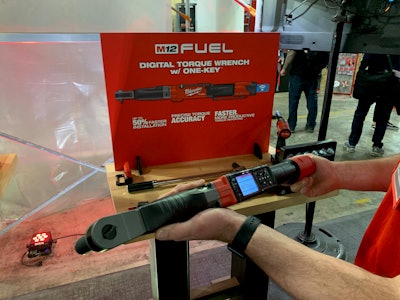 The Ratcheting Torque Wrench spins the nut on and tightens to your chosen torque spec all with the same tool.
The Ratcheting Torque Wrench spins the nut on and tightens to your chosen torque spec all with the same tool.Arguably the most interesting tool introduced at Milwaukee Tools’s recent 2019 New Product Symposium was the M12 Fuel Ratcheting Torque Wrench with One-Key—basically a digital torque wrench with a battery powered motor in it. (M12 refers to the battery platform.) While you can get digital torque wrenches from a lot of manufacturers, Milwaukee put this one over the top with several unique features.
With a manual torque wrench you have to first use a conventional socket wrench to thread on the nut or bolt. When it gets snug you remove that wrench and pick up the torque wrench to do the final tightening to spec—a two-step, two-tool process, often with a lot of manual cranking until the bolt is snug. But the battery in the Milwaukee torque wrench has enough power to spin on the loose bolt or nut. When it gets close to the torque setting you want, the rotation stops. Then you use arm power the last click or two until the correct torque is achieved. It’s a one tool, one step process for both operations.
The Milwaukee Ratcheting Torque Wrench alerts you with an audible beep and a light on the tool’s LED display screen when you’ve hit the torque spec you’ve digitally preset on the tool. If you over-torque the fastener, the tool will give you a red warning light.
For professional mechanics or guys who are working in awkward or difficult spaces, using just one wrench instead of two is a great efficiency booster. Amateur mechanics may not need this one-and-done functionality, but if you turn wrenches for a living you’re going to love it.
Furthermore, Milwaukee built some clever digital features into the tool including the ability to set your torque values in foot-pounds, inch-pounds or the European equivalents: Newton-meters or kilogram-centimeters. With Milwaukee’s One-Key digital system you can also save individual torque events and create a report to show all of your fastener’s target torques and applied torque for record keeping.
The torque wrench is rated at +/- 5-percent accuracy. There are two versions: a 3/8-inch socket size rated for 10 to 100 foot-pounds, and a ½-inch socket size rated for 10 to 150 foot-pounds. Anticipated price is $599 for the bare tool. $799 for the kit with battery and charger. Available in November.
Right-angle die grinder
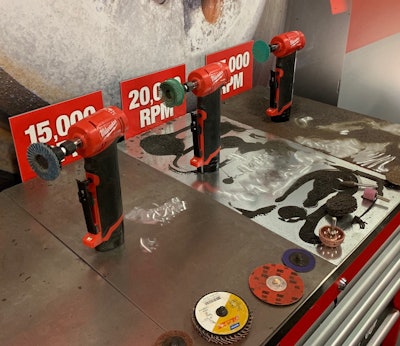 With its compact size the Right Angle Die Grinder is easy to use and store.
With its compact size the Right Angle Die Grinder is easy to use and store.Another tool of interest to mechanics is Milwaukee’s M12 Fuel Right Angle Die Grinder. The die grinder delivers 0.3 horsepower which is 20 percent more than pneumatic models, and its compact size helps it fit in tight spaces and makes it easy to store in a drawer.
A four-mode rpm control from (10,000 to 25,000 rpm) with variable speed trigger will help you finesse grinding and polishing tasks, gasket removal and material abrading. By limiting the rpm to the recommended speed of the grinding tool attachment you won’t inadvertently damage the attachment or the work. You can preset a lower rpm for delicate materials like aluminum and choose high speed for more aggressive material removal.
For run time, the company says the die grinder will do about 250 feet of linear gasket removal (five typical transmission housings) per charge. The Right Angle Die Grinder will be available in October followed by an in-line version in January 2020.
Extended reach ratchets
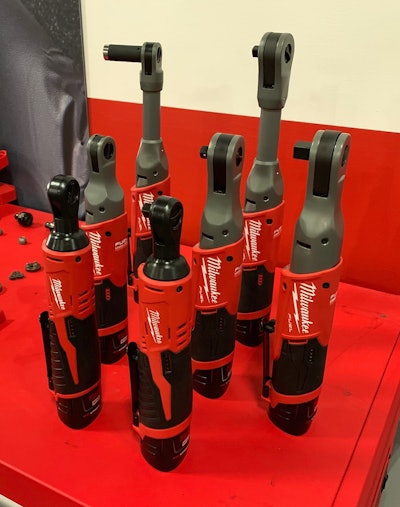 Extended Reach Ratchets get you deep into tight spaces and hard to access areas
Extended Reach Ratchets get you deep into tight spaces and hard to access areasAlso in the M12 Fuel line, Milwaukee has boosted its series of cordless ratchets with the introduction of the M12 Extended Reach Ratchets in the 1/4-inch and 3/8-inch size. Milwaukee introduced cordless ratchets in 2017. This addition takes those same tools and adds about 6 inches of reach to the front end.
This allows you to get deeper into the engine bay and connect with hard-to-reach fasteners while avoiding the knuckle-busting that sometimes happens in cramped spaces. The 3/8-inch ratchet puts out up to 55 foot-pounds of torque, and the 1/4-inch model gives you 40 foot-pounds. The ratchets are made with a cast steel yoke housing, which will stand up to the bending forces on the handle and help the tool last for years.
High torque impact wrench
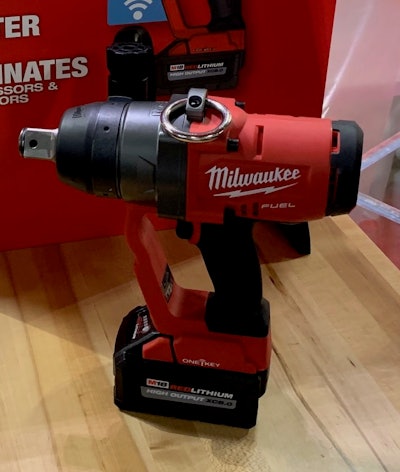 Presets on the High Torque Impact Wrench keep you from over-torqueing fasteners.
Presets on the High Torque Impact Wrench keep you from over-torqueing fasteners.If you change a lot of tires or put down some heavy torque either tightening or busting loose nuts, you’ll want to check out the M18 Fuel 1/2-inch Extended Anvil High Torque Impact Wrench.
What’s unique about this tool is the electronics modulate the torque and allow you to use one of four different settings. This keeps you from over-torqueing fasteners and gets you a lot closer to the desired torque than using torque sticks. The accuracy is ensured thanks to a patented load counting sensor in the tool that registers every impact.
The preset modes start at 75 foot-pounds for light automotive lug nuts, a second setting is geared for SUVs and trucks, a third setting runs up to 450 foot-pounds for box trucks, trailers and semi-trucks, and fourth setting produces 750 foot-pounds of torque. In reverse the impact wrench will crank up to 1,100 foot-pounds to break free even the most stubborn nuts.
Flat sided sockets
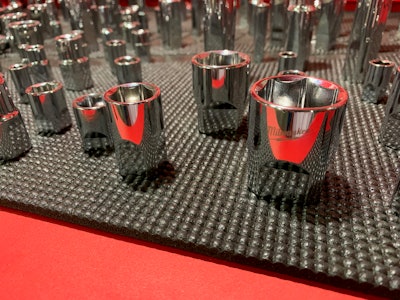 Milwaukee branded flat-side sockets won’t roll away when dropped.
Milwaukee branded flat-side sockets won’t roll away when dropped.And who would have thunk it, but Milwaukee actually came up with something new in the design of sockets.
The company’s Ratchet and Socket sets have a four flat sides at the lower end of the socket where it attaches to the stud on the wrench. These sockets won’t roll away when dropped and when necessary you can grip the flats with pliers or a crescent wrench to apply additional pressure.
The Milwaukee socket sets will be sold in sets and individually, in SAE and metric sizes, 1/4-, 3/8- and 1/2-inch drive. Also available are two accessory breaker bars for the 1/2-inch drive, a 15-inch and 24-inch.






